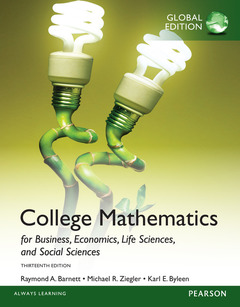Description
College Mathematics for Business, Economics, Life Sciences and Social Sciences, Global Edition (13th Ed.)
Authors: Barnett Raymond A., Ziegler Michael R., Byleen Karl E.
Language: English
Subject for College Mathematics for Business, Economics, Life...:
Approximative price 74.81 €
In Print (Delivery period: 12 days).
Add to cart1044 p. · 21.8x27.3 cm · Paperback
Description
/li>Contents
/li>
For courses covering finite mathematics and/or calculus for students in business, economics, social sciences, or life sciences.
Barnett/Ziegler/Byleen is designed to help students help themselves succeed in the course. This text offers more built-in guidance than any other on the market—
Diagnostic Prerequisite Test
PART ONE: A LIBRARY OF ELEMENTARY FUNCTIONS
1. Linear Equations and Graphs
1.1 Linear Equations and Inequalities
1.2 Graphs and Lines
1.3 Linear Regression
Chapter 1 Review
Review Exercises
2. Functions and Graphs
2.1 Functions
2.2 Elementary Functions: Graphs and Transformations
2.3 Quadratic Functions
2.4 Polynomial and Rational Functions
2.5 Exponential Functions
2.6 Logarithmic Functions
Chapter 2 Review
Review Exercises
PART TWO: FINITE MATHEMATICS
3. Mathematics of Finance
3.1 Simple Interest
3.2 Compound and Continuous Compound Interest
3.3 Future Value of an Annuity; Sinking Funds
3.4 Present Value of an Annuity; Amortization
Chapter 3 Review
Review Exercises
4. Systems of Linear Equations; Matrices
4.1 Review: Systems of Linear Equations in Two Variables
4.2 Systems of Linear Equations and Augmented Matrices
4.3 Gauss-Jordan Elimination
4.4 Matrices: Basic Operations
4.5 Inverse of a Square Matrix
4.6 Matrix Equations and Systems of Linear Equations
4.7 Leontief Input-Output Analysis
Chapter 4 Review
Review Exercises
5. Linear Inequalities and Linear Programming
5.1 Linear Inequalities in Two Variables
5.2 Systems of Linear Inequalities in Two Variables
5.3 Linear Programming in Two Dimensions: A Geometric Approach
Chapter 5 Review
Review Exercises
6. Linear Programming: The Simplex Method
6.1 The Table Method: An Introduction to the Simplex Method
6.2 The Simplex Method: Maximization with Problem Constraints of the Form ≤
6.3 The Dual; Minimization with Problem Constraints of the form ≥
6.4 Maximization and Minimization with Mixed Problem Constraints
Chapter 6 Review
Review Exercises
7. Logic, Sets, and Counting
7.1 Logic
7.2 Sets
7.3 Basic Counting Principles
7.4 Permutations and Combinations
Chapter 7 Review
Review Exercises
8. Probability
8.1 Sample Spaces, Events, and Probability
8.2 Union, Intersection, and Complement of Events; Odds
8.3 Conditional Probability, Intersection, and Independence
8.4 Bayes' Formula
8.5 Random Variables, Probability Distribution, and Expected Value
Chapter 8 Review
Review Exercises
9. Markov Chains
9.1 Properties of Markov Chains
9.2 Regular Markov Chains
9.3 Absorbing Markov Chains
Chapter 9 Review
Review Exercises
PART THREE: CALCULUS
10. Limits and the Derivative
10.1 Introduction to Limits
10.2 Infinite Limits and Limits at Infinity
10.3 Continuity
10.4 The Derivative
10.5 Basic Differentiation Properties
10.6 Differentials
10.7 Marginal Analysis in Business and Economics
Chapter 10 Review
Review Exercises
11. Additional Derivative Topics
11.1 The Constant e and Continuous Compound Interest
11.2 Derivatives of Logarithmic and Exponential Functions
11.3 Derivatives of Products and Quotients
11.4 The Chain Rule
11.4 Implicit Differentiation
11.5 Related Rates
11.7 Elasticity of Demand
Chapter 11 Review
Review Exercises
12. Graphing and Optimization
12.1 First Derivative and Graphs
12.2 Second Derivative and Graphs
12.3 L'Hôpital's Rule
12.4 Curve Sketching Techniques
12.5 Absolute Maxima and Minima
12.6 Optimization
Chapter 12 Review
Review Exercises
13. Integration
13.1 Antiderivatives and Indefinite Integrals
13.2 Integration by Substitution
13.3 Differential Equations; Growth and Decay
13.4 The Definite Integral
13.5 The Fundamental Theorem of Calculus
Chapter 13 Review
Review Exercises
14. Additional Integration Topics
14.1 Area Between Curves
14.2 Applications in Business and Economics
14.3 Integration by Parts
14.4 Other Integration Methods
Chapter 14 Review
Review Exercises
15. Multivariable Calculus
15.1 Functions of Several Variables
15.2 Partial Derivatives
15.3 Maxima and Minima
15.4 Maxima and Minima Using Lagrange Multipliers
15.5 Method of Least Squares
15.6 Double Integrals Over Rectangular Regions
15.7 Double Integrals Over More General Regions
Chapter 15 Review
Review Exercises
APPENDICES
A. Basic Algebra Review
A.1 Algebra and Real Numbers
A.2 Operations on Polynomials
A.3 Factoring Polynomials
A.4 Operations on Rational Expressions
A.5 Integer Exponents and Scientific Notation
A.6 Rational Exponents and Radicals
A.7 Quadratic Equations
B. Special Topics
B.1 Sequences, Series, and Summation Notation
B.2 Arithmetic and Geometric Sequences
B.3 Binomial Theorem
C. Tables
Table I. Basic Geometric Formulas
Table II. Integration Formulas
Answers
Index
Applications Index
A Library of Elementary Functions




